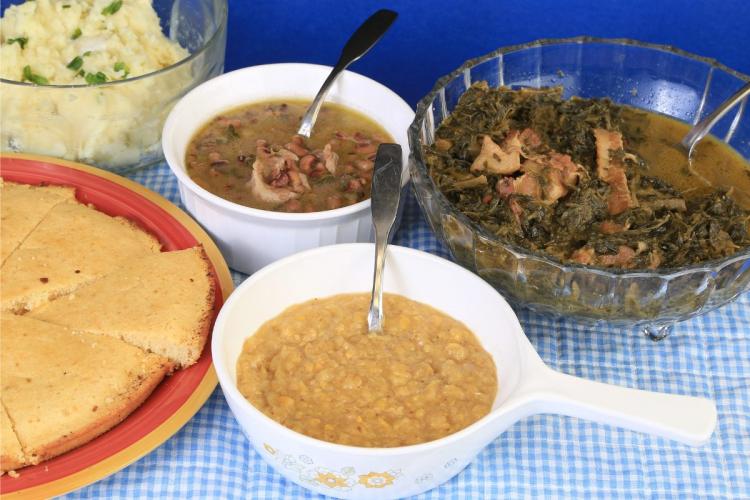Exploring the origins of soul food
A historical perspective.
Soul food, a cuisine deeply rooted in African-American culture and history, offers a culinary journey that tells a story of perseverance, creativity, and community. The rich tapestry of flavors and textures found in soul food dishes has been woven together from the fusion of West African, European, and Native American culinary traditions, transforming humble ingredients into a celebration of life, culture, and heritage. In this exploration of the origins of soul food, we delve into the historical and cultural factors that shaped this unique cuisine and discover how it has evolved over time.
From the kitchens of enslaved African Americans to the bustling soul food restaurants in cities like Atlanta and New York City, soul food has traveled a long and fascinating road, adapting and evolving along the way. In this journey, we’ll uncover the influences that have shaped soul food, the iconic dishes that define it, and the modern variations that cater to a wider range of dietary preferences and health concerns. Let’s embark on a culinary adventure that will tantalize your taste buds and enrich your understanding of this vibrant cuisine.
What soul food is
- Soul food is a cuisine with deep roots in West African and European cooking techniques, as well as influences from Native Americans.
- Soul music has become integral to the popularization of soul food culture, elevating it to a symbol of heritage and pride.
- Modern variations offer healthier alternatives while preserving its rich culinary tradition. Cookbooks provide guidance for home cooks on mastering essential ingredients & techniques.
The roots of soul food
Tracing the origins of soul food, one finds a fusion of West African, European, and Native American culinary traditions. Enslaved African Americans in the Southern United States took the limited ingredients available to them and combined them with their own traditional cooking methods, creating dishes that would eventually become the foundation of southern food and soul food cuisine. From humble beginnings, soul food has grown into a beloved and celebrated part of African American culture, with dishes like fried chicken, collard greens, and sweet potato pie becoming symbols of comfort, community, and resilience.
Soul food dishes are deeply entwined with the history and experiences of African Americans, as well as the flavors and techniques that have been passed down through generations. Next, we will examine:
- The West African influences
- The role of enslaved African Americans
- The evolution of soul food that has culminated in the diverse and delectable cuisine we relish today.
West African influences
One can observe the West African influence on soul food in the spices, vegetables, and cooking techniques that enslaved people brought to the Americas. Ingredients like corn, okra, peppers, sorghum, and black-eyed peas can be traced back to West African cuisine and have become integral parts of the soul food culinary tradition.
Soul food cuisine at its earliest development was heavily influenced by a range of different cultures. These include Indigenous American, European, and most notably African. These cultural influences have shaped the flavors and textures of soul food dishes, reflecting the resilience and creativity of enslaved African Americans as they adapted their traditional dishes to the ingredients available to them in their new environment.
The fusion of these diverse culinary traditions has resulted in the unique and flavorful cuisine we know today as soul food.
Enslaved African Americans
Soul food cuisine significantly benefited from the contributions of enslaved African Americans. Often given the most undesirable parts of animals and limited ingredients, they used their ingenuity and resourcefulness to create flavorful dishes that would become the foundation of soul food. Some examples of dishes that originated from their creativity include:
- Smoked ham
- Corn pudding
- Chitterlings (pig intestines)
- Collard greens
- Fried chicken
- Black-eyed peas
- Sweet potato pie
Pork and corn were two staples in the Southern United States for both slave owners and slaves, with the slave owners having smoked ham and corn pudding while the enslaved were provided with the offal.
Enslaved people were often provided a meagre share of food rations as part of their sustenance. Cornmeal and 3-4 pounds of pork per week served as the main source for African American soul food. They combined these meager rations with the knowledge and techniques they brought from their native lands, creating dishes that showcased their culinary prowess and determination to make the most of their limited resources.
The legacy of enslaved African Americans can be seen in the soul food dishes we enjoy today, a testament to their resilience and creativity in the face of adversity. Their contributions to this cuisine have left an indelible mark on the culinary landscape of the United States, shaping the flavors, textures, and traditions that define soul food.
The evolution of soul food
Several key factors significantly influenced the evolution of soul food as it continued to develop. The great migration of African Americans from the rural South to urban areas in the early 20th century saw them taking their culinary traditions with them and adapting them to new contexts. Additionally, the rise of gospel sound and soul music in the 1950s and 1960s helped popularize soul food as a cultural expression of African American identity.
These factors contributed to the diversification and popularization of soul food, taking it beyond its humble origins and transforming it into a cuisine that celebrates the rich history and cultural heritage of African Americans.
Next, we will examine the role of the great migration and the influence of gospel sound and soul music on the development of soul food.
The great migration
The great migration saw African Americans moving from the rural South to urban areas such as New York City and Chicago, taking their culinary traditions with them and adapting them to new environments. This mass movement of people not only introduced soul food to new audiences, but also exposed African Americans to the culinary practices of other immigrant cultures, leading to the incorporation of new flavors and techniques into their own dishes.
The great migration played a crucial role in the spread and evolution of soul food cuisine, as African Americans carried their culinary heritage with them to new cities and communities. The influence of this migration can still be seen today in the soul food scenes of cities across the United States, showcasing the resilience and adaptability of this cuisine and its creators.
Gospel sound and soul music
The rise of gospel sound and soul music in the 1950s and 1960s also played a significant role in the popularization of soul food. Gospel music, originating from African-American culture and spirituality, and soul music, which developed from gospel and blues, both contributed to the cultural expression of African American identity. The passionate and emotive qualities of these musical genres are mirrored in the sumptuous and flavorful dishes that constitute soul food.
The connection between gospel sound, soul music, and soul food has helped to create a sense of unity and camaraderie around this cuisine, making it more than just a meal but a cultural experience. The vibrant and soulful sounds of gospel and soul music have not only brought people together but also helped to elevate soul food to a symbol of African American heritage and pride.
Iconic soul Food dishes
Fried chicken, collard greens, and sweet potato pie, three iconic soul food dishes, have delighted the hearts and taste buds of generations. Each of these dishes has its own unique history and cultural significance, reflecting the diverse influences and culinary traditions that have shaped soul food cuisine as a typical soul food meal.
Next, we will explore the histories and significance of these cherished dishes in greater depth.
Fried chicken
Fried chicken is a staple soul food dish, with its roots in West African and European cooking techniques. It gained popularity among enslaved African Americans because they were frequently granted the opportunity to raise chickens, and over time, African American cooks transformed fried chicken into a quintessential Southern dish, closely associated with soul food. Its popularity increased internationally in the 1970s, with KFC playing a major role in its influence.
Today, fried chicken continues to be a beloved dish in soul food cuisine, showcasing the creativity and resourcefulness of the cooks who first developed it. The crispy, golden crust and tender, juicy meat have become synonymous with comfort and celebration, making fried chicken an enduring symbol of soul food’s rich history and cultural significance.
Collard greens
Collard greens, often cooked with pork, are a popular choice in Southern American cooking due to West African influences. These dark, leafy greens have their origins in West African cuisine and were introduced to the United States by enslaved African Americans. Collard greens are typically cooked with pork fat and seasoned with a combination of vegetables, resulting in a hearty and flavorful side dish that is an integral part of soul food cuisine.
The history and cultural significance of collard greens showcase the resilience and ingenuity of the enslaved African Americans who first prepared them. With their rich flavors and textures, collard greens have become a beloved symbol of soul food’s deep connection to African culinary traditions and the perseverance of those who created this cuisine.
Sweet potato pie
Sweet potato pie is a highly esteemed dessert in soul food cuisine, with its roots in African and Native American culinary customs. This delectable dessert features a sweet and creamy filling made from mashed sweet potatoes, flavored with warm spices like cinnamon and nutmeg, and baked in a flaky crust. The popularity of sweet potato pie can be attributed to the influence of African and Native American culinary traditions, which made use of sweet potatoes, spices, and other ingredients.
Today, sweet potato pie continues to be a cherished dessert in soul food cuisine, enjoyed by many during holiday celebrations and family gatherings. Its rich flavors and comforting warmth speak to the heart of soul food, embodying the resourcefulness, creativity, and love that have gone into the creation of this unique and beloved cuisine.
Modern soul food variations
Soul food cuisine has evolved alongside societal changes and shifts in dietary preferences. Modern soul food variations include healthier versions of traditional dishes, as well as vegan adaptations and mostly vegetarian diet options, catering to a wider range of dietary preferences and health concerns at a soul food restaurant.
These innovative takes on classic soul food dishes not only provide more inclusive options for diners but also showcase that not all southern food is the same, highlighting the adaptability and versatility of this rich culinary tradition.
Healthier soul food
Healthier soul food focuses on reducing fat, sodium, and cholesterol content while maintaining the flavors and essence of traditional dishes. These modifications have enabled soul food to be healthier without compromising its flavor and cultural significance. Examples of healthier soul food dishes include:
- Slow cooker smothered turkey wings
- Waffle-fried chicken
- Creole crab cakes
- Fried fish and grits
- Smothered oxtails
- Salmon croquette patties
These dishes attempt to modify traditional soul food recipes with modern techniques and flavors, offering a lighter and more health-conscious alternative to classic dishes. This evolution in soul food cuisine demonstrates its adaptability and resilience, as it continues to appeal to new generations of diners while honoring its rich cultural heritage and history.
Vegan soul food
Vegan soul food adapts classic recipes to exclude animal products, offering a plant-based alternative for those seeking a cruelty-free and environmentally friendly option. Vegan soul food is generally lower in saturated fat and cholesterol than traditional soul food and may also provide a good source of fiber, vitamins, and minerals. Examples of vegan adaptations of traditional soul food dishes include:
- Vegan mac and cheese
- Vegan collard greens
- Vegan fried chicken
- Vegan gumbo
- Vegan cornbread
The growing popularity of vegan soul food showcases the versatility and inclusivity of this cuisine, as it continues to evolve to cater to a wider range of dietary preferences and health concerns. This innovation in soul food demonstrates its ability to adapt and thrive in a changing culinary landscape while still honoring the flavors, textures, and traditions that define it.
Soul food restaurants and scenes
Cities like Atlanta and New York City host soul food restaurants and scenes, each presenting a unique interpretation of this diverse and rich culinary tradition. These establishments cater to a wide range of tastes and preferences, showcasing the depth and variety of soul food dishes.
In the following sections, we’ll explore the soul food scenes in Atlanta and New York City, two cities with thriving soul food communities and a passion for this flavorful cuisine.
Atlanta
Atlanta is known for its vibrant soul food scene, with numerous restaurants offering both traditional and modern interpretations of classic dishes. The city’s tradition of soul food is entrenched in its history of slavery and nearby plantations, and Atlanta’s soul food has been shaped by the African legacy and reflects the cultural contributions of enslaved Africans, Amerindian, and European culinary influences.
Some of the most esteemed soul food restaurants in Atlanta include Busy Bee Cafe, Mary Mac’s Tea Room, and Paschal’s. These establishments not only serve delicious soul food dishes but also contribute to the preservation and celebration of the rich history, culture, and tradition of soul food in Atlanta and beyond.
New York City
New York City also boasts a thriving soul food scene, with establishments catering to a diverse clientele and offering a taste of Southern comfort in the bustling city. The cultural diversity and history of New York City have facilitated the integration of various cultures and cuisines, resulting in the emergence of distinctive soul food dishes and the incorporation of new flavors and techniques into the cuisine.
Harlem, a neighborhood in New York City, is host to a number of iconic soul food restaurants and tours, including Sylvia’s, Red Rooster, and Harlem Soul Food Tours. These establishments and tours provide a unique experience of soul food, featuring its distinctive flavors and ingredients, and offer a taste of the rich history and cultural heritage of this beloved cuisine.
Cooking soul food at home
The rewarding experience of cooking soul food at home allows one to recreate classic dishes and explore new flavors in a familiar environment. With the help of cookbooks, recipes, and essential ingredients and techniques, aspiring chefs can bring the flavors and traditions of soul food cuisine to life, creating meals that not only nourish the body but also feed the soul.
Soul food is a cuisine that has been passed down through generations, and it is a great representation of the soul food culture.
Cookbooks and recipes
For those aspiring to recreate classic dishes at home, soul food cookbooks and recipes provide guidance and inspiration. Notable authors and cookbooks in the soul food genre include:
- Abby Fisher, the author of the first soul food cookbook
- Edna Lewis, a celebrated traditional Southern chef and author
- Vertamae Grosvenor, whose cookbook, Vibration Cooking, or the Travel Notes of a Geechee Girl, focuses on spontaneity in the kitchen and cooking by “vibration”
These cookbooks and recipes provide invaluable insights into the flavors, ingredients, and techniques that define soul food, allowing home cooks to explore the rich culinary heritage of this cuisine and create dishes that celebrate the history and culture of African Americans.
Essential ingredients and techniques
Generations have passed down essential ingredients and techniques for soul food cooking, including the use of spices, vegetables, and various cooking methods. Spices such as cayenne pepper, garlic, onion, and paprika add depth and flavor to soul food dishes, while vegetables like collard greens, okra, sweet potatoes, and tomatoes provide essential nutrients and textures.
Cooking methods commonly employed in soul food cuisine include frying, stewing, and baking, each lending a unique texture and flavor to the dishes being prepared. By mastering these essential ingredients and techniques, home cooks can recreate the soulful flavors of traditional soul food dishes and explore the rich cultural heritage of this unique cuisine.
Deep southern food
Throughout this exploration of the origins and evolution of soul food, we have discovered the rich history, cultural significance, and diverse influences that have shaped this beloved cuisine. From its roots in the fusion of West African, European, and Native American culinary traditions, to the ingenuity of enslaved African Americans and the impact of the great migration and gospel sound and soul music, soul food has grown into a vibrant and celebrated part of African American culture.
As we continue to enjoy the flavors and traditions of soul food, we are not only savoring delicious dishes but also honoring the resilience, creativity, and community that have been the foundation of this cuisine for centuries. With each bite, we celebrate the history and heritage of soul food, and the enduring spirit of those who have contributed to its rich tapestry.
What food is considered soul food?
Soul food is a cuisine traditionally made up of an entrée such as fried or smothered chicken, fish or pork, with sides including stewed greens, black-eyed peas and candied yams, and desserts like banana pudding or cobbler. Cornbread is often served alongside the meal, as well as a beverage such as red drink.
What does soul food come from?
Soul food is an African American cuisine originating from the Deep South, with its roots in the rural South. It was developed by enslaved Africans using meager food rations provided to them during the Transatlantic Slave Trade, and gained popularity during the rise of "Black pride" in the 1960s. Soul food is a unique cuisine that has been passed down through generations, and is still enjoyed today. It is a reflection of the African American experience, and is a source of pride and identity for
How has soul food evolved over time?
Soul food has undergone a transformation over time, integrating aspects of the great migration, gospel and soul music, modern dietary preferences and health concerns. This has resulted in healthier versions of traditional dishes and even vegan adaptations being incorporated.
What are some iconic soul food dishes?
Popular soul food dishes include fried chicken, collard greens, and sweet potato pie.
Where can I find soul food restaurants and scenes?
Soul food restaurants and scenes can be found in cities such as Atlanta and New York City, providing an opportunity to explore the diversity and richness of this culinary tradition.




